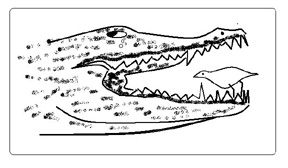Symbiosis is like “Outsourcing”
Some organisms entrust even basic living functions to other creatures to perform on their behalf, says
S.Ananthanaryanan.
Organisations that find some activity to be outside their own core area of expertise often engage an external agency to take it over. Examples are security, sanitation,
courier services – agencies that arrange for these services thrive because many prosperous companies provide them with good income to take care of these onerous essentials of their own business. In time, the mother industry cannot do without the service provider
and the provider also does well, thanks to the former.
Symbiosis
It is quite like the symbiotic relationship between living organisms. The word usually refers to the relation between organisms that live in intimate
contact, with each receiving life sustaining support from the other.
 A classic example of symbiosis is of the Egyptian Plower and the crocodile. A number of parasites, insects, or bits of decaying meat, too small for
the crocodile to deal with, infest the crocodile’s mouth. In the interest of cleaning its mouth of this potentially harmful contamination, the crocodile patiently allows the Plower free access to its fearsome
A classic example of symbiosis is of the Egyptian Plower and the crocodile. A number of parasites, insects, or bits of decaying meat, too small for
the crocodile to deal with, infest the crocodile’s mouth. In the interest of cleaning its mouth of this potentially harmful contamination, the crocodile patiently allows the Plower free access to its fearsome
Mouth, and the bird feeds on the insects and cleans the crocodile’s teeth. The bird finds ample food and is always content
that no predator dare approach its feeding area.
More familiar examples are of the bacteria that live in our digestive tract. They find a safe and comfortable dwelling and they pay the rent by myriad
roles in the digestion of food, beyond the capacity of the juices and enzymes that the body itself produces.
Extreme case
But the most startling case of an organism having specialized to such an extent that its very basic living functions are performed by other organisms
that live in its body is the instance of the marine worm, Olavius algarvensis, reported in
Nature this week.
Olavius is about 3 cms long and lives in oxygen-deficient sediments in the Mediterranean an in the East Pacific
ocean. The interesting thing is that it has evolved to have no mouth, no digestive tract and no anus. It derives its energy and eliminates body waste through the action of a community of different bacteria that live just below its skin, as it moves up an down
in the oxygen starved and slightly oxygenated slime at the bottom of the ocean.
Another interesting thing is that this class of worm and this kind of symbiosis has not been studied so far, because the bacteria cannot be cultured
outside their natural environment, which is under the host-worm’s skin. It is recently that molecular and genetic methods of studying the bacteria have been able to shed light on the mechanisms in action.
The Sulphur cycle
Normal life forms, like we see on the surface of the earth, consume carbon and oxygen and excrete and exhale oxides. While the body processes work by
oxidizing carbon, different processes, based on plant life and photo synthesis, reduce the oxides and replenish the stock of food for organisms. Related processes have also created the store of petroleum reserves which man-made processes are now consuming.
In the case of the
Olavius worm, there are two broad classes of bacteria – one sulphur reducing and the other sulphur oxidizing. Through the methane and hydrogen sulphide gasses in the sea-floor ooze, the bacteria provide the worm with carbon-based energy tokens,
called ATP, to enable muscles to work or cells to grow, at the sulphur oxidising site, while the products (like sulphates) get rejuvenated (to sulphides) at the sulphur reduction site.
With both consumption and supply mechanisms located right under its skin, the
Olavius worm has no need for mouth, intestines, anus, sewage, the rain cycle, and so on, like all of us!
[The writer can be contacted at simplescience@gmail.com]